Lyons W.C. (ed.). Standard handbook of petroleum and natural gas engineering.2001- Volume 1
Подождите немного. Документ загружается.

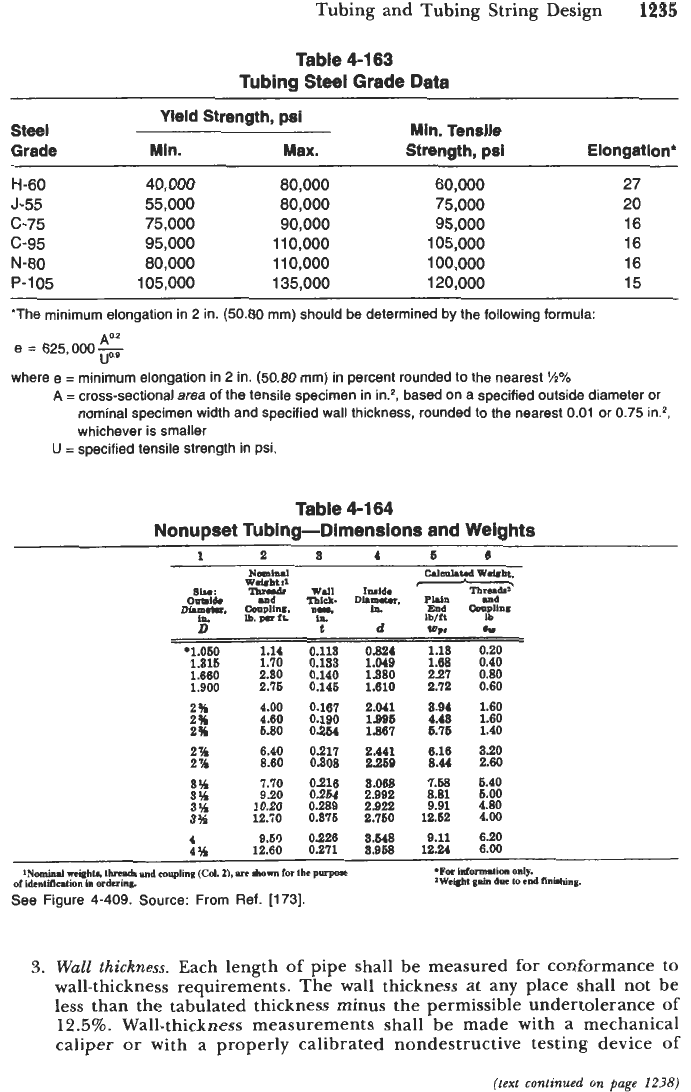
Tubing and Tubing String Design
1235
Table 4-1
63
Tubing Steed Grade Data
Yield Strength, psi
Steel Min. Tensile
Grade
Mln. Max.
Strength, psi Elongation'
H-60
40,000
80,000
60,000 27
c-75
75,000
90,000
95,000 16
c-95
95,000
11
0,000
105,000 16
N-80
80,000
11
0,000
100,000 16
P-105
105,000
135,000 120,000 15
'The minimum elongation in
2
in.
(50.80
mm) should be determined by the following formula:
J-55 55,000
80,000
75,000
20
AO.2
e
=
625,000
uo.o
where e
=
minimum elongation in
2
in.
(50.80
mm) in percent rounded
to
the nearest
%%
A
=
cross-sectional area of the tensile specimen in
in2,
based on a specified outside diameter or
nominal specimen width and specified wall thickness, rounded to the nearest
0.01
or
0.75
in?,
whichever is smaller
U
=
specified tensile strength in psi.
Table 4-164
Nonupset Tubing-Dimensions and Weights
I
2
8
4 6 6
Nmld
WdAtd
udsht.
Thrud...
Wd.htil
ah:
-
Wdl
Immld.
00t.i.j.
md
nick-
~i.-.
PW~
ud
B
Ib.Drt
In.
t
d
w,,
.u
*1.050
1.14
0.118
0.824
1.18 0.20
1.815
1.70
0.183 1.019
1.68
0.40
1.660
2.80
0.140 1380
2.27
0.80
1.900
2.76 0.146
1.610
2.72 0.60
End
IXmDllnr
lb/ft
Ib
DL.~*,
aplinr.
n.15
in.
4.00 0.167 2.041 8.94
1.60
2K
4.60 0.190 1.996 4.48 1.60
2)L 2%
5.80
0.254
1.867
6.76
1.40
6.40 0.217 2.441 6.16
8.20
"%
2% 8.60
0308
2.269
8.44
2.60
7.70 0216 8.068
7.M
5.40
334
8%
9.20 0.264 2.992 8.81
5.00
3%
10.20 0.289 2.922 9.91 4.80
3% 12.70 0.376 2.760 12.62 4.00
4 9.50 0226
8.548
9.11 6.20
434 12.60 0.271 8.958 12.24
6.00
*For
inlormmtian
only.
gsin
dme
to
cad
finishing.
1.N-d
yeiqh&
ulrrnd.
and mupiing
(Cd.
2). are
horn
lor
the
purpme
of
~dmlfidaon
I.
ordrriw
See Figure
4-409.
Source: From Ref. 11731.
3.
Wall
thickness.
Each length
of
pipe shall be measured for conformance to
wall-thickness requirements. The wall thickness at any place shall not
be
less than the tabulated thickness minus the permissible undertolerance
of
12.5%.
Wall-thickness measurements shall be made with a mechanical
caliper or with a properly calibrated nondestructive testing device
of
(text
continued
on page
1238)
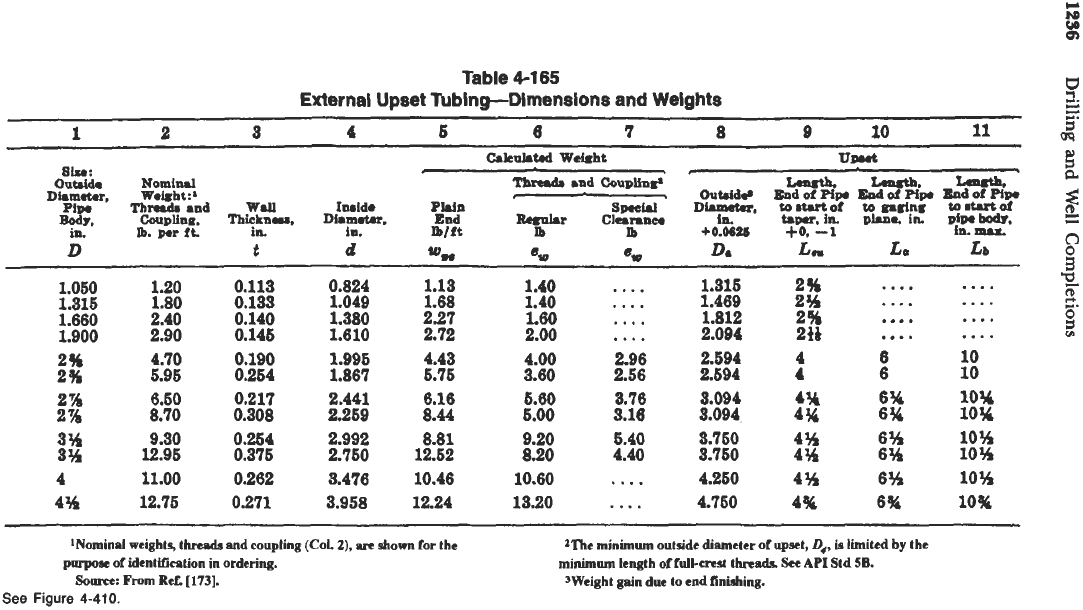
c
Eo
w
0,
1.050
1.315
1.660
1.900
2%
2%
2%
2%
3%
3%
4
4%
0.113
0.133
0.140
0.145
0.190
0.254
0.217
0.308
0.254
0.375
0.262
0.271
0.824
1.049
1.380
1.610
1.995
1.867
2.441
2.269
2.992
2.750
3.476
3.958
1.13
1.68
2.27
2.72
4.43
5.75
6.16
8.44
8.81
12.52
10.46
12.24
~~
1.40
1.40
1.60
2.00
4.00
3.60
5.80
5.00
9.20
8.20
10.60
15.20
....
....
....
....
2.96
2.56
3.70
3.16
5.40
4.40
....
....
1.315
1.469
1.812
2.094
2%
2%
2%
2
4)
2.594
2.694
3.094
3.094
3.750
3.750
4.250
4.750
4
4
4%
4%
4%
4%
4%
4%
e...
....
....
....
6
6
6%
6%
6%
6%
6%
6%
....
....
....
....
10
10
10%
10%
10%
10
%
10%
10%
U
3,
e
5'
1
2
3
4
6
6
7 8 9
10
11
09
Uput
B
81u:
Lautk
x.mstb.
-
a
6
in.
lb.
Der
ft
in
in.
v
c'-nca
lb
Table
4-165
External Upset Tubing-Dimensions and Welghts
C.kllkt.d
Wdht
otlwd.
Nomind
F-
'ad
cwpllne
oUt.id#
Ead
d
Pi-
End
of
Pi-
End
of
Pi#
Dhmetu.
W*i.bt:'
spccm'
DW,
toatartof
t~p..ing
tom-of
f
Pkln
Thh-gd
tag?!^.
Dim*.
lb,ft
Inaide
e
t.p.r.in.
ph16
in.
uI#bodt.
End
hL
in.
+0.0691)
+o.-1
D
t
d
WU
C
C
D.
L,
LO
Lb
1.20
1.80
2.40
2.90
4.70
5.95
6.50
8.70
9.30
12.95
11.00
12.76
'Nominal weights, threads
and
coupling
(Col.
Z),
are
shown
for
the
Somce: From
Ref.
[173].
2The minimum outside diameter
of
upset,
D,,
is limited
by
the
'Weight gain due
to
end
finiahing.
purpose
of
identification in ordering. minimum length
of
full-crest
thnds.
Scc
API
Std
5B.
See
Figure
4-410.
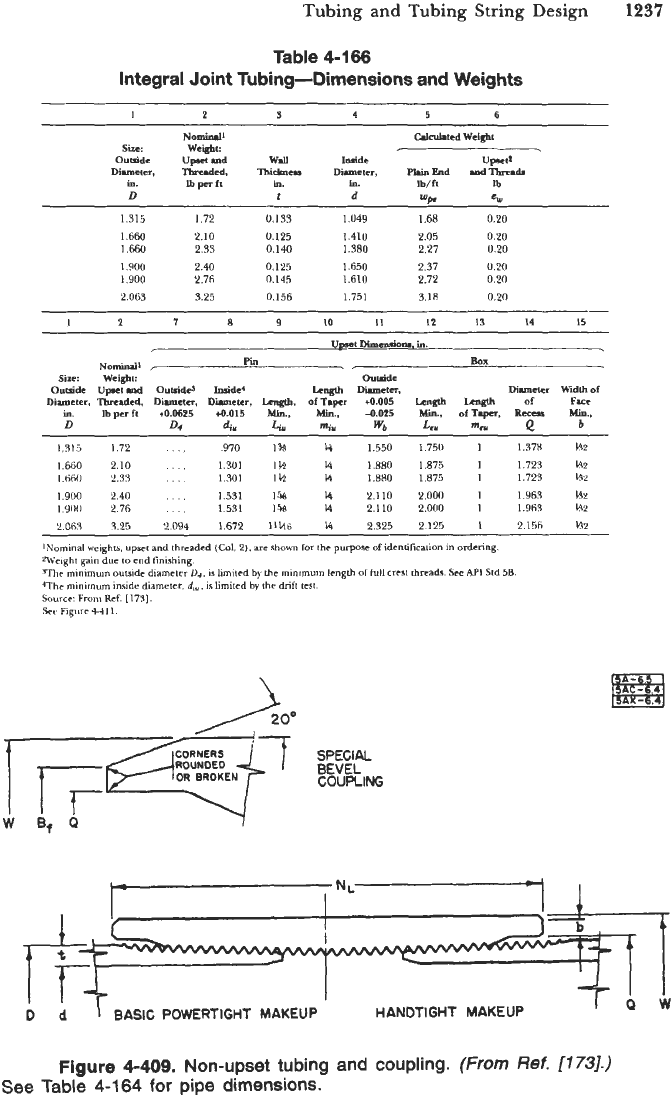
Tubing and Tubing String Design
1237
Table
4-166
Integral Joint Tubing-Dimensions
and
Weights
1
2
S
4
5
6
size:
Outside
Diameter,
in.
D
1.315
1.660
1.660
1.900
1900
2.063
1.72
2.10
2.33
2.40
2.76
3.25
~~
CnlNL.ted
Weight
W.ll
Inside
Upet'
t
e,
WP
d
0.133
1.U49
1.68
0.20
0.125
1.410
2.05
0.20
0.140 1.380 2.27 0.20
0.125 1.650 2.37 0 20
0.145
1.610
2.72
0.20
0.156
1.751
3.18 0.20
Tbidm~
Dbeler,
-End
mdbds
in.
in.
Ib/ft
Ib
I
2
7
8
9
10
11 12
13
14
15
UIlOet
Dimmdnu,
in.
pin
NomLull
,
Sire:
Weial:
Outside
Upsetmd
Outside,
Ina'de'
Dipmeter,
Threaded,
Diameter, Dinmeter,
Lmgth.
in.
Ibperft
+O.O6P5
d.015
Mbr.,
D
04
di.
L,
1.315
1.72
. . .
,
,970
1%
1.660 2.10
.
,
1.301
IM
I.tiR(I
2.53
.
.
1301
IM
1.900
4.40
. . .
,
1.531
158
1.9011
2.76
. .
1.531
1%
9.065 "1.29
2.094
1.672
1lLL6
Box
I_
Outside
length
Diameter,
Diameter
Min..
-0.09.5
Min.,
ofTaper,
Reeaa
ofTaper
4.005
rCn@
Len@ of
ntiv
wb
La
ma
Q
H
1.550 1.75~
I
1.m
H
1.880
1.875
1
1.723
L4
1,880
I875
1
1.723
14
2.110
2.0MI
1
1.963
1$
2.110
2.000
1
1.9R5
W
2.525
2.125
1
2.15fi
Wadth
of
Fee
Min.,
b
H2
82
LQe
192
M2
M2
1Nominal
welghts,
upset
and
threaded (Col.
2).
are
rho- for the
purpose
of
identification
L"
ordering.
Weight
gain
due
10
endfinuhing.
4hc
minimum
outside diameter
D+,
is
limited
by
the
minimum
length
of
full
crest
Breads. See
API
Std
5B
4The
minimum inside diameter.
d,",
IS
hired
by
the
drift
test.
Sourcc.
From
Ref.
[I731
LrFigiire+IlI
D
d
BASIC
POWERTIGHT MAKEUP HANDTIGHT MAKEUP
Figure
4-409.
Non-upset tubing and coupling.
(From
Ref.
[173].)
See
Table
4-164
for
pipe dimensions.
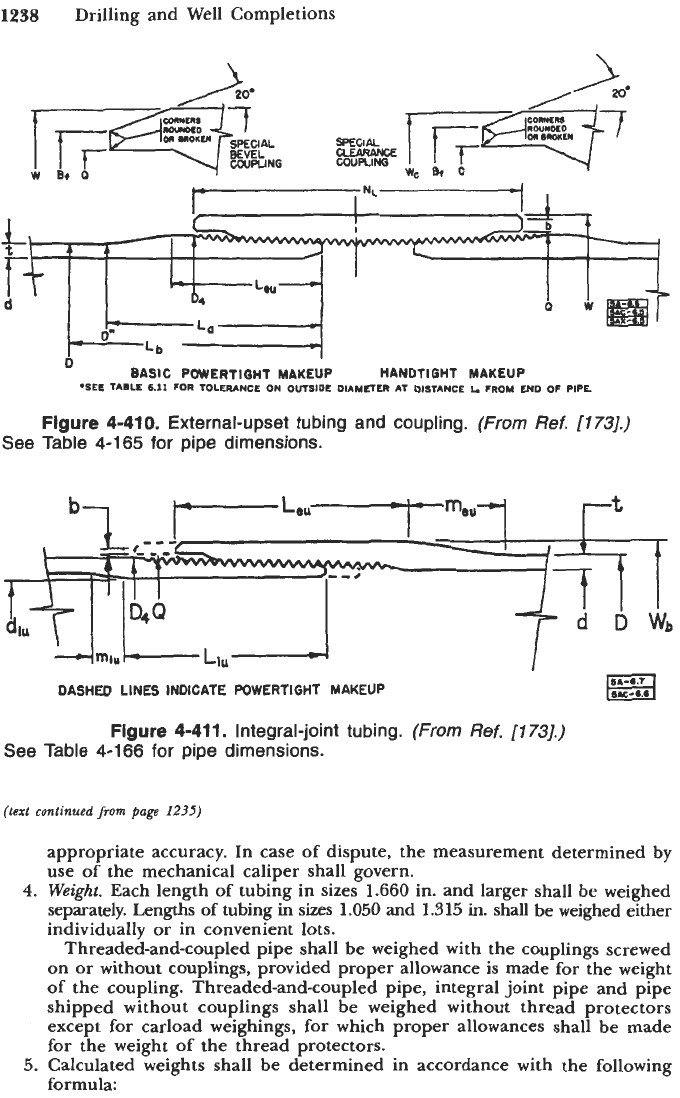
1238
Drilling and Well Completions
BASIC
POWERTIGHT
MAKEUP HANDTIGHT MAKEUP
*SEE
TIELL
6.11
fOR
TOLERANCE
ON
OUTSIDE
DIAMETER
AT
OISTANCE
L.
FROM
END
OF
PIPE
Figure
4-410.
External-upset tubing and coupling.
(From
Ref.
17731.)
See Table
4-165
for pipe dimensions.
DASHEO
LINES INDICATE
POWERTIGHT
MAKEUP
Figure
4-411.
Integral-joint tubing.
(From
Ref.
[773].)
See Table
4-166
for pipe dimensions.
(text continued
from
page
123s)
appropriate accuracy. In case of dispute, the measurement determined by
use of the mechanical caliper shall govern.
4.
Weight.
Each length of tubing in sizes
1.660
in. and larger shall be weighed
separately. Lengths
of
tubing
in
sizes
1.050
and
1.315
in.
shall be weighed either
individually or in convenient
lots.
Threaded-and-coupled pipe shall be weighed with the couplings screwed
on or without couplings, provided proper allowance is made for the weight
of
the coupling. Threaded-and-coupled pipe, integral joint pipe and pipe
shipped without couplings shall be weighed without thread protectors
except
for
carload weighings, for which proper allowances shall be made
for the weight of the thread protectors.
5.
Calculated weights shall be determined in accordance with the following
formula:

Tubing and Tubing String Design
1239
W,
=
(Wpe
x
L)
+
e,
where W,
=
calculated weight of a piece of pipe of length
L
in lb (kg)
Wpe
=
plain-end weight in lb/ft (kg/m)
L
=
length of pipe, including end finish, as defined below in ft (m)
e,
=
weight gain or loss due to end finishing in lb (kg) (for plain-
6.
Length.
Pipe shall be furnished in range lengths conforming to the following
as specified on the purchase order: When pipe is furnished with threads
and couplings, the length shall be measured to the outer face of the
coupling, or if measured without couplings, proper allowance shall be made
to include the length of the coupling. For integral joint tubing, the length
shall be measured to the outer face of the box end.
end pipe, e,
=
0)
Pipe Range Lengths
Range
1
Range
2
Total range length' 20-24 28-32
Permissible variation, max. 2 2
Permissible length, min.
20 28
Range length
for
100%
of
carload:+
'By agreement between purchaser and manufacturer, the total range length for
Range
1
tubing may
be
6.10-8.53
m.
'Carload tolerances shall not apply to orders less than a carload shipped from the
mill. For any carload of pipe shipped from the mill
to
the final destination without
transfer or removal from the car, the tolerance shall apply to each car. For any order
consisting of more than a carload and shipped from the mill by rail, but not to the
final destination in the rail cars loaded at the mill, the carload tolerances shall apply
to the total order, but not to the individual carloads.
Performance Properties
Tubing performance properties, according to API Bulletin 5C2, 18th Edition
(March 1982), are given in Table
4-167.
Formulas and procedures for calculating
the values in Table
4167
are given in API Bulletin 5C3, 3rd Edition (March
1980).
Running and Pulling Tubing
The following are excerpts from "API Recommended Practice for Care and
Use of Casing and Tubing," API RP
5C1,
12th Edition (March 1981).
Preparation and Inspection before Running
1.
New tubing is delivered free of injurious defects as defined in API Standard
5A, 5AC and 5AX, and within the practical limits of the inspection
procedures therein prescribed. Some users have found that, for a limited
number of critical well applications, these procedures do not result in
casing sufficiently free of defects to meet their needs for such critical
applications. Various nondestructive inspection services have been employed
by users to assure that the desired quality of tubing is being run. In view
of this practice, it is suggested that the individual user:
(text continued on page
1246)
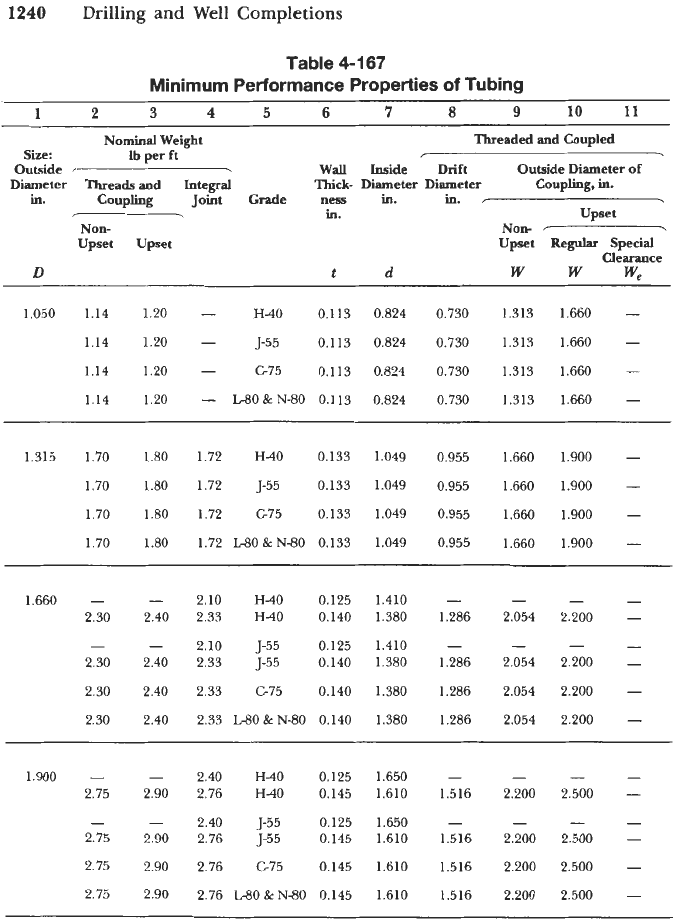
1240
Drilling and Well Completions
Table
4-167
Minimum Performance Properties
of
Tubing
1
2
3
4
5
6
7
8
9
10
11
Nominal
Weight Threaded and Coupled
Size:
lb
per ft
r
7
Outside
r
.
Wall
Inside Drift Outside Diameter of
Diameter Threads
and
Integral
Thick-
Diameter Diameter
coupling,
in.
-.
in.
Upset
in.
Coupling Joint Grade
ness
in.
in.
r
.
Non-
Non-
r
.
Upset Upset Upset Regular Special
D
1.050 1.14 1.20
-
H40 0.113 0.824 0.730 1.313 1.660
-
1.14 1.20
-
5-55 0.113 0.824 0.730 1.313 1.660
-
1.14 1.20
-
G75 0.113 0.824 0.730 1.313 1.660
-
1.14 1.20
-
L80&N-80 0.113 0.824 0.730 1.313 1.660
-
1.315 1.70 1.80 1.72 H40 0.133 1.049 0.955 1.660 1.900
-
1.70 1.80 1.72 5-55 0.133 1.049 0.955 1.660 1.900
-
1.70 1.80 1.72 G75 0.133 1.049 0.955 1.660 1.900
-
1.70 1.80 1.72
L80&
N-80 0.133 1.049 0.955 1.660 1.900
-
1.660
-
-
2.10 H40 0.125 1.410
-
- - -
2.30 2.40 2.33 H-40 0.140 1.380 1.286 2.054 2.200
-
-
-
2.10 5-55 0.125 1.410
-
-
- -
2.30
2.40
2.33 5-55 0.140
1.380 1.286
2.054 2.200
-
2.30
2.40 2.33 C75 0.140 1.380
1.286
2.054 2.200
-
2.30
2.40 2.33
L-80
&
N-80 0.140 1.380
1.286
2.054 2.200
-
1.900
-
-
2.40 H40 0.125 1.650
- -
-
-
2.75 2.90 2.76 H40 0.145 1.610 1.516 2.200 2.500
-
-
-
2.40 J-55 0.125 1.650
- -
-
-
2.75
2.90 2.76 5-55 0.145
1.610
1.516
2.200 2.500
-
2.75
2.90 2.76 C75 0.145
1.610 1.516
2.200 2.500
-
2.75
2.90 2.76 L808~N-80 0.145
1.610 1.516
2.200 2.500
-
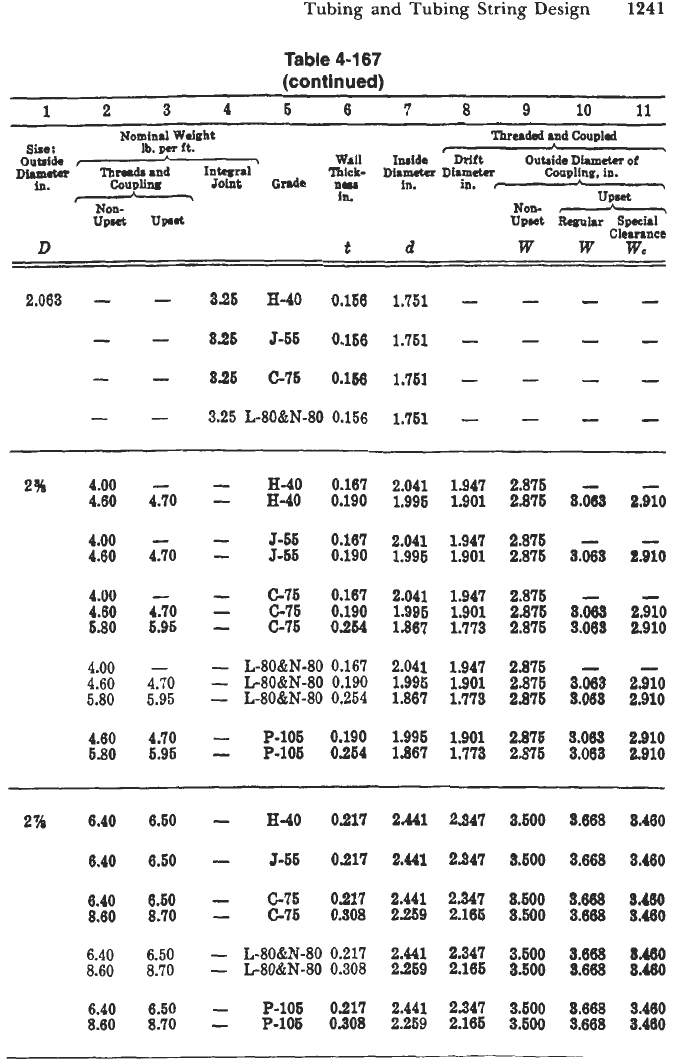
Tubing and Tubing String Design
1241
Table
4-1
67
(continued)
1
2
3 4
6
6
7
8 9 10 11
Nominal
Weight
Thruded
and
Coupled
~.UWW
Thdand
InWml
Thick-
Dhmctcl
Dhp-
Coupling.
in.
She:
lb.
per
It.
r
outside
I
,
Wall
Imide
Dtift
OutsideDi8meterof
in.
COUPh
Joint
GdC
nu
in.
in.
Y
Non-
-
Uptet
Regular
Spmid
Cleurncr
in.
UP&
e
UP&
Upld
D
t
d
w
w
we
2.063
-
-
326
H4O
0.166 1.751
-
-
-
-
-
-
3.26
J-66
0.166 1.761
-
-
- -
- -
3.26 C-76 0.166 1.761
-
-
-
-
- -
3.25
L-80&N-80
0.156 1.761
-
-
-
-
236
4.00
4.60
-
4.70
-
H-40
0.167
-
H-40
0.190
2.041 1.947
1.996 1.901
2.876
-
2.876 3.G 2.910
-
5-66
0.167
-
5-65 0.190
2.041 1.947
1.996 1.901
2.876
-
2.876 3.&3 2.910
4.00
4.60
-
4.70
4.00
4.60
6.80
-
C76
0.167
-
C-76
0264
-
C76
0,190
2.041 1.947
1.996 1.901
1.867 1.773
2.876
-
2.876
3.G
2.910
2.875 3.063 2.910
-
4.70
6.96
4.00
4.60
5.80
-
L-80&N-80
0.167
-
G80&N-80 0.190
-
L-80&N-80
0.264
2.041 1.947
1.996 1901
1.867 1.773
2.876
-
2.876 3.&3 2310
2.876 3.068 2.910
-
4.70
5.95
-
P-106
0.190
-
P-106 0264
1.996 1.901
1.867 1.773
2876 3.063
2310
2.876 3.063
2.910
4.60
6.80
4.70
6.96
2%
6.40 6.60
-
H-40
0217
2.441 2.347 3.600 3.668 3.460
-
f-66
0.217
2.441 2347 3.600
2.441 2.347 3.600
2.259 2.166 3.600
3.668
8.460
6.40 6.SO
6.40
6.60
8.60 8.70
-
(3-76
0217
-
C76
0.308
3.888
3.668
8.480
3.460
-
L-80&N-80
0.217
-
L-80&N-80 0.308
2.441 2.347
3.600
2369 2.166 3.600
3.668
3.668
am
3.460
6.40 6.50
8.60
8.70
-
P-106 0217
-
P-106 0308
2.441
2347
3.600
2.259
2.166
3.600
3.668
3.668
3.460
3.460
6.40 6.50
8.60
8.70
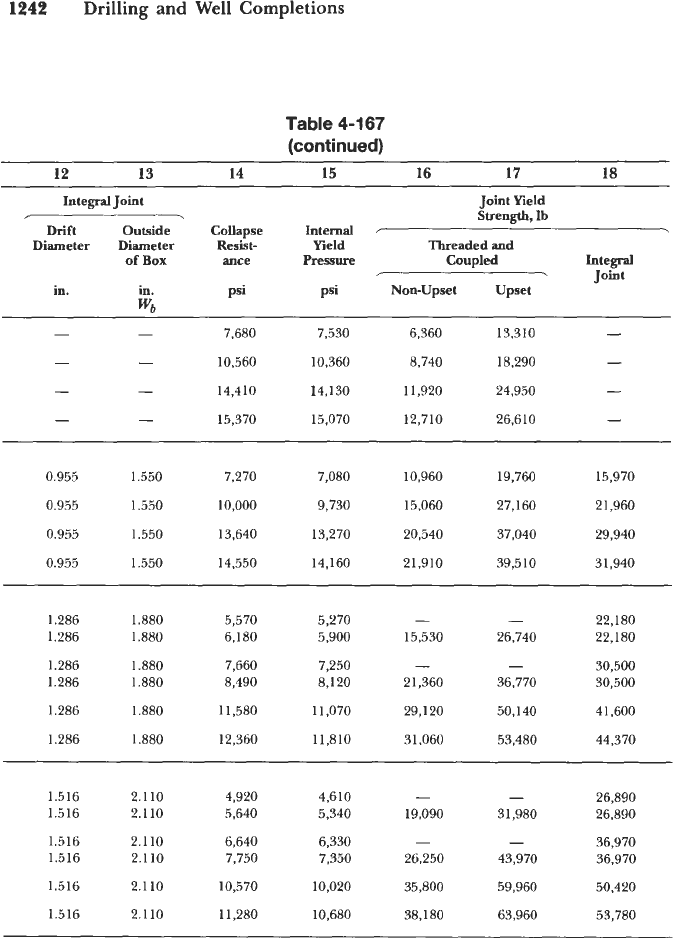
1444 Drilling and Well Completions
Table
4-167
(continued)
12
13
14
15
16
17
18
Integral Joint Joint Yield
I
,
Saength, lb
Drift Outside Collapse Internal
r
,
Diameter Diameter Resist- Yield Threaded
and
of
Box
ance
PreSSUre
Coupled Integral
,-
,
Joint
in.
in.
psi psi Non-Upset Upset
Wk
-
-
7,680
7,530 6,360
13,310
-
-
-
10,560
10,360 8,740 18,290
-
-
-
14,410
14,130 11,920 24,950
-
- -
15,370
15,070 12,710 26,610
-
0.955 1.550
7,270 7,080 10,960 19,760
15,970
0.955 1.550 10,000 9,730 15,060 27,160 21,960
0.955 1.550 13,640 13,270 20,540
37,040 29,940
0.955
1.550 14,550
14,160 21,910
39,510 3 1,940
1.286 1.880
5,570
5,270
-
-
22,180
1.286 1.880 6,180
5,900 15,530
26,740 22,180
1.286 1.880 7,660
7,250
-
-
30,500
1.286 1.880 8,490
8,120
21,360 36,770 30,500
1.286
1.880 11,580
11,070
29,120 50,140 41,600
1.286 1.880 12,360 11,810
31,060 53,480 44,370
-
26,890
1.516 2.110 4,920 4,610
-
1.516 2.110 5,640 5,340 19,090 3 1,980 26,890
1.516 2.110 6,640 6,330
-
-
36,970
1.516 2.110
7,750
7,350 26,250
43,970 36,970
1.516 2.110
10,570
10,020 35,800
59,960 50,420
1.516
2.110 11,280
10,680 38,180
63,960 53,780
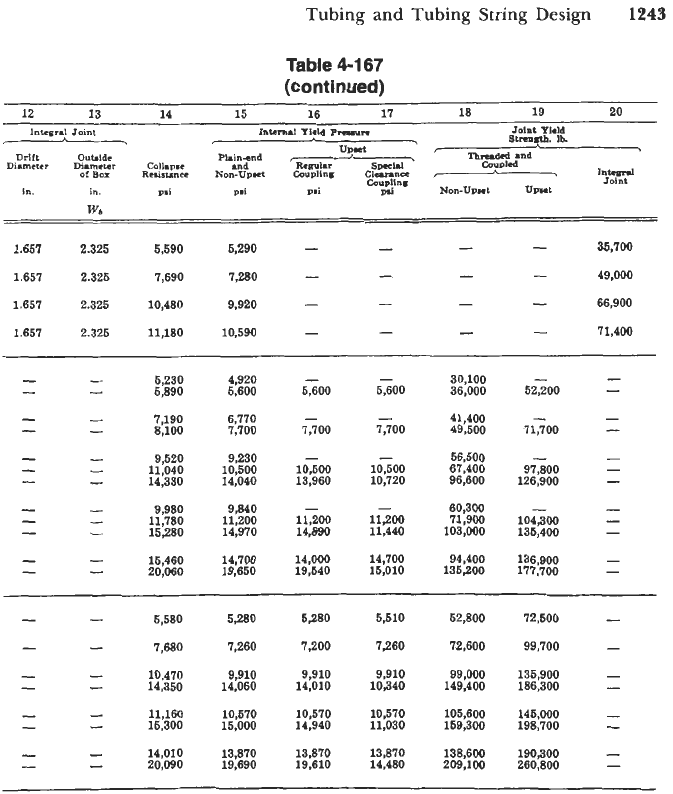
Tubing
and
Tubing String Design
1243
Table
4-1
67
(continued)
12 13 14 15 16 11 18 19 20
Joint
Yield
Stmtath.
Ib
-.
J
Integral
Joint
Inlernd
Yield
P-n
UP&
'
Thd
and
CouDkd
Phin-end
___JI__
Reau1.r
spew
and
Drift
Outddc
Diameter Diameter
Coliapsc
of
Box
Rt.isuncc
Non-UDd
Couplins
ClannoC
'tz
Coup'inr
Non-Upd UDUt
in.
in.
mi
P.i
D.i
Dai
Wb
1.657
2.325
5,590
5,290
- -
- -
35,700
1.651
2.325
7,690
7,280
-
-
- -
49.000
1.651 2.325 10,480
9,920
-
-
-
-
66,900
1.657
2.325
11,180
10.590
-
-
-
-
71,400
-
-
-
-
-
5,230
4,920
-
-
30,100
-
-
5,890
5,600
5,600
5.600 36,000 52,200
-
-
41,400
-
-
-
-
56,500
-
-
-
- -
7,190 6,110
-
-
8,100 1,100 1,700 7,100 49,500 11,700
-
I
9,520 9.230
67,400 97,800
-
I
11,040 10,500 10,500 10,500
-
-
14,330 14,040 13,960 10,120 96,600 126,900
-
-
-
-
60,300
- -
-
-
15,280 14,910 14,890 11,440 103,000 135,400
-
-
-
-
9,980 9,840
-
-
11,180 11,200 11,200 11,200 71,900 104,300
-
-
- -
15,460
14,700
14,000
14,100 94,400
136,900
-
-
20,060
19,650 19,540
16.010
135,200 111,700
-
-
5,580
5,280
6.280
5,510 52,800
12,500
-
-
-
1,680
1,260 1,200
1,260
12,600 99,100
-
-
I
10,410
9,910 9,910
9,910 99,000
135,900
-
-
-
I
14,350 14,060 14,010 10,340 149,400 186,300
-
-
11,160
10,670 10,510
10,510 105,600
145,000
-
-
-
15,300
15,000 14.940
11,030
169,300 198,100
-
-
-
14,010
13,810
13.870
13,870
138,600 190,300
-
-
-
20,090
19,690 19,610
14,480 209,100
260,800
-
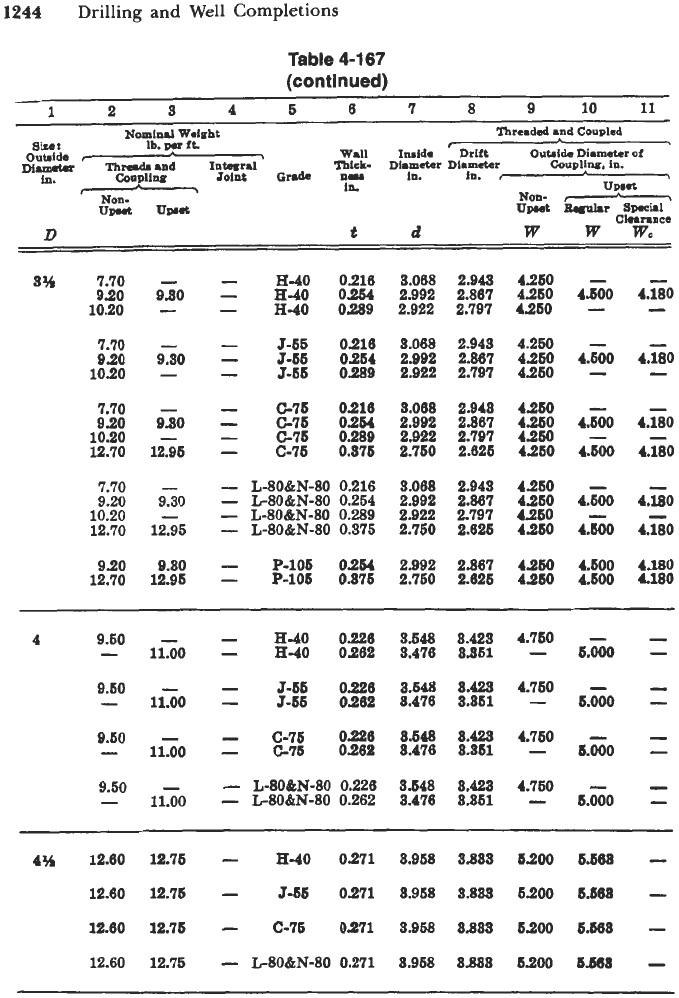
1244
Drilling
and
Well Completions
Table
4-167
(continued)
9 10
11
1
2
3
4
6
6 7
8
Nomid
Weight
Threaded
and
Coupled
Thick-
Diameter Diameter
Coupling,
in.
I
Wall
Inside
Drift
Oubide
Diameter
of
in.
Sire:
Ib.
rn
it.
Ouuide
in.
Diw
Threadsand
IIItesrd
CoODlinP
Joint
G&
nu
in.
in.
r
UDIe
Nom-
0
Clearance
Non-
Urn
Runkr
Sweial
urn
up.*
D
t
d
w
w
we
3%
7.70
9.20
10.20
7.70
9.20
10.20
7.70
9.20
10.20
12.70
7.70
9.20
10.20
12.70
9.20
12.70
9.60
-
4
9.60
-
9.60
-
9.60
-
4%
12.60
12.60
12.60
12.60
-
930
-
9.30
-
930
12.96
-
-
9.30
12.95
-
9.30
12.96
-
E40
0.218
-
H-40
0.264
-
H-40
0.289
-
J-66
0.216
-
J-66
0.264
-
5-56
0.289
-
E76 0.216
-
C-76
0.264
-
C-76 0.289
-
(2-76
0.376
-
L-80&N-80
0.216
-
G80&N-80
0.264
-
L-808tN-80
0.289
-
G80&N-80
0.575
P-106
P-106
0.264
0.376
s.068
2.94
2.992 2.867
2.922 2.797
3.068
2.943
2.992 2.887
2.922 2.797
3.068 2.943
2.992 2.867
2.922 2.797
2.760 2.626
3.068 2.943
2.992 2.867
2.922 2.797
2.760 2.626
2.992 2867
2.760 2.626
4.260
-
-
4.260 4.600
4.180
4.260
-
-
4.260
-
-
4.260 4.600
4.180
4.250
-
-
4.260
-
4.260
4.600
4.GO
4.260
-
-
4.260
4.600 4.180
4.260
-
4.260
4.600
4.zO
4.260
-
-
4.260
4.600
4.180
4.260
4.600
4.180
4.260
4.600
4.180
-
-
H-40
0.226
11.00
-
8-40
0.262
-
J-66
0.228
11.0
-
J-66 0.282
1170
-
C-76
0.262
-
C-76
OB6
- -
L-808tN-80
0.226
11.00
-
G80&N-80
0.262
12.76
-
H-40
0.271
12.76
-
J-66 0.271
12.76
-
C-76
0.271
12.75
-
L-806N-80
0.271
a.648
8.w
3.476 3.861
3.548
3.428
3.476 3.361
3.648
3.428
3.476 3.861
3.968
3.883
3.968
3.883
4.760
-
-
-
6.OOo
-
4.760
-
-
-
6.000
-
4.760
- -
-
6.000
-
4.760
-
-
-
6.000
-
6.200
6d68
-
6200
6.668
-
6.200
6.668
-
